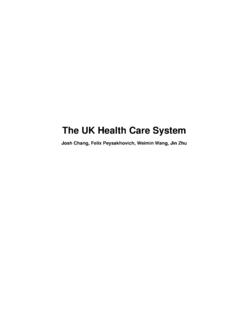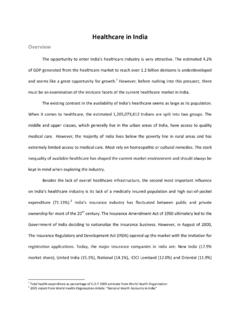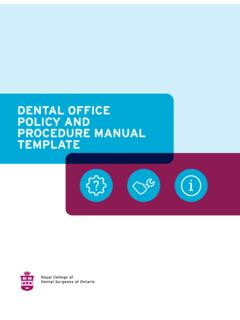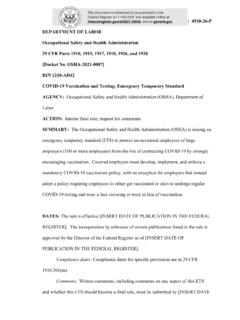Transcription of Healthcare System in Singapore - Columbia University
1 Healthcare System in Singapore ACTU4625 TOPICS: HEALTH INSURANCE. Yu BAI, Chaoran SHI, Xiaoteng LI,& Feifei LIU. Background Singapore , an island country with population of million, is well-known for its efficient and widely covered Healthcare System . The early primary health care, after Singapore 's independence in 1965, started with a mass-inoculation program against severe tropical epidemic diseases. In order to provide convenience to the out-patient attendances, the government extended the network of hospitalization, including general hospitals, satellite out-patient dispensaries and maternal and child health clinics. Healthcare ranked as the fifth priority for public funds. To foresee and avoid the future problems, Government promoted a National Health Plan in 1983. It detailed the infrastructural plan for the next 20 years together with the idea of Medisave.
2 In 1985, the restructuring of public sector hospitals started to merge the business and financial disciplines into health care services for the purpose of providing higher quality of services and financing efficiently (Lim, 1998). The expenditure of national health care was maintained at the level of 3% of GDP through the period of 1980s to 1990s. The dollar term steadily increased every year from 1967 to 1995. In 2002, the government promulgated the ElderShield plan so as to help the elders and the severe disabled in particular. Healthcare System Regulators The philosophy of Singapore 's Healthcare System consists of three pillars. Firstly, the country is aimed to build up a healthy population with preventive health cares and to encourage healthy lifestyles. Secondly, Singapore also emphasizes personal responsibility towards healthy living through the 3M (Medisave, Medishield and Medifund) System .
3 Lastly, the government has to keep the Healthcare costs down by controlling the supply side of the Healthcare services and providing heavy subsidies at public Healthcare institutions. There are three main regulators in the System , Minister of Health (MOH), Central Provident Fund (CPF) and Monetary Authority of Singapore (MAS). MOH oversees the provision and regulation of Healthcare services. Specifically, it is in charge of promoting health education, monitoring the accessibility and quality of Healthcare services, preventing and controlling diseases, allocating resources and specialists and administrating required licenses for Healthcare establishments. CPF is a comprehensive and compulsory social security savings plan. It ensures working Singaporeans and permanent residents (PRs) to support themselves in the old age.
4 CPF has expended its objectives to meet the population's needs in retirement, housing, family protection, asset enhancement and Healthcare . Workers and employers are required to make monthly contributions to the employees' CPF into three accounts, ordinary account, special account and the Medisave account. MAS, as Singapore 's central bank, regulates the financial aspect of insurance sector. The 1. Insurance Department of MAS administers the insurance Act, which protects the interests of policyholders and regulates insurers' activities, including registration and licensing requirements. Periodically, MAS provides directions and practice notes for regulating insurance activities. Healthcare Delivery System Singapore 's Healthcare delivery System provides population the primary Healthcare , hospital care, long-term care and other integrated care.
5 Singapore has an island network of outpatient polyclinics and private medical practitioner's clinics to provide primary medical treatments, preventive Healthcare as well as health education. Eighty percent of primary Healthcare services are offered by 2000 private medical clinics; whereas the remaining is delivered by 18 government polyclinics. Hospital care consists of inpatient, outpatient and emergency services. By contrast to primary Healthcare , public hospitals provide 80% of hospital care. The public hospitals are structured by regions with five clusters: Alexandra Health Pte Ltd (AHPL), Jurong Health Services (JHS), National University Health System (NUHS) National Healthcare Group (NHG) and Singapore Health Services (SHS). There are two leading private providers are Raffles Medical Group and Parkway Health.
6 Detailed providers list is shown in Table 1. In 2010, there were 11,509 hospital beds, out of which 8881 beds are from public sectors and 2628 beds are from private providers. The numbers of registered doctors (excluding specialists) and nurses serving in the public institutions are 8819 and 12994 respectively. Whereas, the corresponding numbers for private sector are 3292 and 5140. (Department of Statistics Singapore , 2011). Healthcare Financing PUBLIC FINANCING. The public financing for Healthcare System consist mainly by 3M , shorted for Medisave, MediShield and Medifund, plus ElderShield being promoted most recently. Medisave is a national medical insurance scheme through which members build savings for their Healthcare needs. In addition to hospitalization expenses and certain outpatient treatments for members and immediate family members, Medisave can be used to pay for MediShield premiums and Private Medical Insurance Scheme (PMIS) as well.
7 Monthly contribution to the Medisave Account is mandatory for CPF members. The rates are determined based on retained age, ranging from 7% to 9% of monthly salary, up to at most S$41000 per year (Ministry of Health Singapore , 2010). Members can claim their hospital charges including in-patient charges and surgical expenses. Medisave can also be used to 2. cover outpatient treatments, subject to the withdrawal limit. As the increase in the total population, the number of Medisave accounts goes up to three million with a total balance of billion. The annual amount withdrawn by each member is around S$732 on average. (Ministry of Health Singapore , 2012). MediShield, as a complementary plan to Medisave, is a catastrophic medical insurance that enables members to settle part of the expenses arising from prolonged hospitalization and certain outpatient treatments for serious illnesses incurred in medical institutions involved.
8 Singapore citizens and PRs are eligible to opt in the scheme. The annual premiums increase by ages from S$33 with age below 30, to S$1,123 with age between 84 and 85. Medishield does not provide coverage to people aged 85 years old and above. Rates for members in other ages are outlined in table 5. The number of Medishield policyholders reached to million, out of which about million policyholders also enrolled in PMIS. (Ministry of Health Singapore , 2012). ElderShield is an affordable severe disability insurance which provides basic financial protection to those who need long-term care, especially for elder population. Prior to September 31, 2007, Eldershield paid S$300 monthly for maximum 60 months, which was known as Eldershield300; thereafter, the benefit was increased to S$400 monthly up to 72. months (Eldershield400) to pay the out of pocket expenses.
9 MOH has appointed three private insurers, Aviva, Great Eastern and NTUC Income, to run ElderShield. Singapore citizens and PRs enrolled in Medisave are automatically covered under ElderShield at the age of 40. Eldershield requires level premium calculated based on the entry-age. Premiums are payable annually until members reach 65 years old. Medifund is an endowment fund set up by Singapore government to help citizens and PRs whose Medisave and MediShield are inadequate to pay the medical expenses. The fund will be added when the budget surplus available. The total size of Medifund amounts was S$ billion by 2010. The amount a patient can claim under Medifund depends on the financial and social circumstances. The application for Medifund is subject to the approval of Medifund-approved institutions (MFI).
10 By the end of 2010, MFI had approved 481 million applicants for Medifund assistants. The number increased by from 410 million approved applicants in 2009. (Ministry of Health Singapore , 2012). PRIVATE FINANCING. Despite resources from public financing, currently, there are five private insurers, including American International assurance , Aviva, Great Eastern Life, NTUC Income and Prudential assurance . All of them offer private health insurance plans for individuals and groups. The plans share similar coverage and benefits, such as in-patient & out-patient medical expenses, surgical costs, critical illness treatments, disability and long-term care. Detailed products of each insurer are listed in table 6. 3. Through private insurers, there are two types of plans being offered, known as Private Medical Insurance Scheme (PMIS) and Non-PMIS Private Medical Insurance.






